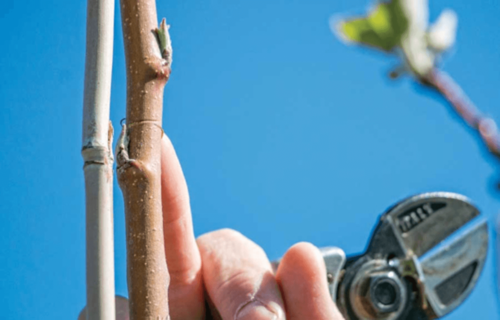COSMIC CRISP™ SET FOR EXPLOSIVE START
YAKIMA, Wash. — The countdown to takeoff for Cosmic Crisp has begun.
Though commercial planting of trees won’t begin until next year and the apple be available to consumers until 2020, shipments of the variety could approach 5 million cartons by 2022.
Cristy Warnock, operations manager at Proprietary Variety Management, Yakima, said there were initial thoughts that only about 450,000 trees would be available for planting in 2017, but that amount was increased to 700,000 trees because of more trees were propagated than first thought.
A drawing was conducted to portion out available trees to interested growers in Washington growers. Those trees will be delivered next spring, she said.
Article by Tom Karst, The Packer
NURSERIES PROPAGATE MILLIONS OF COSMIC CRISP™ BRAND TREES
EPHRATA, Wash. — Ricardo Santacruz stoops over a small rootstock tree and slices a notch in its trunk a few inches above the ground so fast that if you blink you’ll miss it.
With equal speed he slices a bud from a short chunk of Cosmic Crisp apple limb from a bundle of them on his hip, places the bud in the notch and moves onto the next tree.
Cosmic Crisp is the new Washington State University variety the Washington apple industry believes will become more popular than Honeycrisp and hopes is the state apple of the future.
Article by Dan Wheat, Capital Press
GROWING COSMIC CRISP
Researchers Offer More Tips For Growing WA 38, Including Girdling.

PHOTOS BY ROSS COURTNEY FROM GOOD FRUIT GROWER
Stefano Musacchi, research horticulturalist for the Washington State University Tree Fruit Research and Extension Center, discusses the “click” technique of management on Cosmic Crisp plantings during a field day at WSU test plots. The effects of the click system were less evident in a V-trellis, shown above, because trees are planted closer together.
Researchers are already finding Washington State University’s latest apple variety, WA 38, to be grower friendly, but they’re learning more about it each season as commercial production grows closer.
That includes how to horticulturally manage this highly vigorous, tip-bearing variety, whose apical dominance can result in large caliper branches that present significant blind wood.
“When we get these highly vigorous situations, renewal pruning is going to be a critical component of the horticultural program,” said Tom Auvil, research horticulturist with the Washington Tree Fruit Research Commission. “We have to be very careful about how we prune and thin a vigorous orchard.”
Stefano Musacchi, Washington State University horticulturist and endowed chair in tree fruit physiology and management, notes that this cultivar can produce a high number of secondary clusters, or lateral clusters, on one-year wood, which in some cases can range from 20 to 40 percent of the total flower count on a WA 38 tree.
That’s according to data from WSU’s Sunrise research orchard near Quincy, Washington.
And unlike most other varieties, WA 38, known under the brand name Cosmic Crisp, produces high-quality fruit on spurs and one-year wood.
Managing the blind wood also offers other benefits: It reduces the amount of bloom that could be struck by fire blight, minimizes transplant issues and keeps the fruit all in one place, next to the tree, which will be ideal for mechanical harvest, Auvil said.
“And technically, I think it will improve yields, because the more sites where fruit can grow, the less blind wood, the more fruit we’ll harvest,” he said.
Researchers presented their latest findings on WA 38 horticultural practices in April during tours of two plantings at WSU’s research orchards in Quincy and Prosser, Washington.
Reducing The Blind Wood
Musacchi recommends notching and girdling just as deep as the bark and phloem to reduce blind wood. He says bending tends to result in two to three more nodes of blind wood than clicking-type pruning methods.
Researchers have examined a number of ways to minimize the other effects of apical dominance in WA 38, including girdling and notching the central leader and different pruning techniques — a “click” system vs. bending limbs and fastening to the trellis wire.
Musacchi is adopting a click pruning technique. This method involves tipping the end of the branches on one-year wood to minimize the blind wood.
Tipping once at 1 year old, then returning the following year to tip again, leaving two to three vegetative buds, will help to increase bud swelling at the base of the branch and reduce the blind wood.
Bending tends to result in two to three more nodes of blind wood than clicking-type pruning methods, Musacchi said.
Girdling is ideal for WA 38 trees on a bi-axis training system, because growers don’t want to lose 2 feet of crop to blind wood, especially in a fruiting wall, Musacchi said.
He recommends a very light girdle around just the bark and the phloem, “every foot, sometimes even more often — every 5 to 6 inches — if necessary.”
“Honestly, the girdling did extremely, extremely well,” he said. “There is no blind wood through all the length of the fruiting wall.”
Musacchi did not girdle a spindle block planted as finished trees, which had significant feathers — 20 to 30 feathers per tree for trees on Geneva 41 rootstocks, and 10 to 15 feathers per tree for those on Malling 9 Nic 29 rootstocks. This means that girdling can be adopted only if necessary.
Generally, the click system is resulting in better bud breaks the following year, but it’s more effective in vigorous conditions, Musacchi said.
However, in a V system, because the trees are planted closer together and are less vigorous, the effects were not as evident, because the length of the branches is shorter.
In addition, a mechanical pruning trial at the Prosser, Washington, site is showing promise. Mechanical pruning cuts off the tips of branches, thus removing their inherent apical dominance, and helps to stimulate bud break closer to the trunk, or axe, of the tree and minimize blind wood, Musacchi said.
Researchers mechanically pruned for the first time last year, then did so again in February.
The result: Every cut is resulting in one, two or three buds close to the axe, minimizing the blind wood and ensuring short limbs that improve fruits’ exposure to sunlight.
Mechanically pruning also prepares a fruiting wall for mechanical harvest in a couple of different ways, Auvil said.
Eliminating longer fruiting limbs from rows reduces the potential for damage by limbs that could be sucked into a vacuum harvester, damaging fruit that enter the machine when a limb is in the wrong place.
“The other really, really big advantage for the robotics format, particularly for the bi-ax system, in looking at mechanical pruning, is the uniformity of color and maturity,” he said.
Pollinizer Reminder
Researchers are also reminding growers who intend to plant WA 38 to remember to order their pollinizers.
Growers should strive to get two different pollen sources distributed in each block — every 30 feet for every row — such as a Mount Everest and a Snowdrift, or midseason commercial apple varieties, such as Red Delicious, Golden Delicious, Granny Smith or Cameo, Auvil said.
Article by Shannon Dininny, Good Fruit Grower
COSMIC CRISP GETTING AN OUT-OF-THIS-WORLD RECEPTION FROM APPLE GROWERS, BREEDERS
YAKIMA, Wash. — Washington’s first newly bred apple variety is soaring in popularity a full four years before the first commercial crop is expected to hit the market.
Developed by Washington State University Extension in Wenatchee, the new variety — Cosmic Crisp — is the offspring of the Honeycrisp and Enterprise varieties. Experts say the new apple is more resilient to disease and damage, has good texture, excellent taste and superior storage life. And that, coupled with the apple sharing the same harvest window as the once-dominant Red Delicious, has growers excited.
Tree orders from growers have shot up from 700,000 next year to about 2 million the following year, said Cristy Warnock, operations manager of Proprietary Variety Management in Yakima, the firm marketing Cosmic Crisp for WSU.
Northwest Nursery Improvement Institute, a grower organization of fruit tree nurseries throughout the Northwest, has propagation rights to grow the seedlings at various nurseries across the state. WSU will collect royalties from the trees and crops.
Article by Phil Ferolito, Yakima Herald
THE HONEYSCRIP REVOLUTION
How One Apple Transformed Produce Purchasing
Chefs and food lovers have long been some of America’s loudest health and environmental advocates. But over the last ten years, farm-to-table dining has spread from the elite tables of Northern California to the counters of national burrito chains. Today, even casual diners are expected to understand their lunch’s impact on their health and the health of the planet. That’s why we’ve created a series called conscious cuisine found here and distributed through the Conde Nast Media Network in Bon Appetit and WIRED. This series explores the complex relationship our meals have with the ecosystem at large. Be warned, you may never look at an apple the same way again.
Article by Claudine Ko
COSMIC CRISP APPLE TREE ORDERS SKYROCKET
YAKIMA, Wash. — Orders for Cosmic Crisp apple trees, the new Washington State University variety, are taking off faster than anyone in the industry has ever before seen.
The initial 2017 release, through an already completed grower drawing, will likely be 700,000 trees, says Cristy Warnock, operations manager of Proprietary Variety Management in Yakima.
Growers have ordered more than 2 million trees from Washington nurseries for planting in the spring of 2018, Warnock says. Some 700,000 more trees are on order so far for 2019.
“As far as we know, this is the largest launch of any apple variety ever in the world,” Warnock said. “We’re looking at a ballpark of 3.5 million in the first three years.”
PVM is coordinating the commercialization of Cosmic Crisp for WSU.
It took Pink Lady 10 to 15 year to get to 7 million trees planted, and at the current rate Cosmic Crisp will surpass that in its first five years, she said.
Cosmic Crisp, a cross between Honeycrisp and Enterprise apples developed in 1997 by WSU apple breeder Bruce Barritt, is exclusive to Washington nurseries and growers.
Usually, new varieties, exclusive to one company, start at 50,000 to 100,000 trees planted in the first two years, said Lynnell Brandt, president of PVM and Brandt Fruit Trees. To minimize risk, companies wait to see how the variety does before planting more, he said.
With Cosmic Crisp, the risk is spread over the entire industry. Major companies are working collectively on standards, marketing and retail, and consumer feedback has been extremely good so growers are eager to start in a big way, Warnock said.
“The industry believes in it and is getting to participate in all aspects. Momentum is unlike anything we’ve ever seen before,” she said.
The industry and WSU will be involved in all aspects, from best growing practices and research on tree training to fruit storage and marketing.
“I think it will set a new bar on how to introduce new selections commercially on behalf of industries,” Brandt said, adding it’s beginning to change the thinking of major companies from competition to collaboration.
Orders are from a cross section of small and large growers, he said.
“I don’t think we’ve ever seen a variety introduced at such an aggressive level,” said Tom Auvil, research horticulturalist at the Washington Tree Fruit Research Commission in Wenatchee.
Nurseries don’t have enough rootstock so growers are changing orders from other varieties to Cosmic Crisp to use rootstock planned for those varieties, he said.
Rootstock for 2018 trees won’t be budded until August, so growers can switch 2018 orders until then if nurseries are willing, he said.
Pete Van Well, president of Van Well Nursery in East Wenatchee, agrees with Warnock and Brandt that Cosmic Crisp is the largest launch of any new apple variety ever.
“I don’t know of any other variety that’s gone that fast in the first three years,” Van Well said.
The limiting factor so far has been enough bud wood, but that’s only been for 2017 and 2018 and shouldn’t be a factor for the 2019 crop, he said.
Bud wood can be buds or small chunks of limb with buds on them that are inserted into rootstock.
Cosmic Crisp from trial plots has been taste tested in stores but commercial sales are unlikely until 2020.
“It’s a very good apple. It’s good eating, storing and producing. So far, it appears to be excellent. The whole industry is pleased. It will be one of the major varieties pretty quickly and in 10 years it could be the new state apple,” Van Well said.
Seven major nurseries in Central Washington each produce more than 1 million trees per year, Van Well said. But that includes many varieties of apples, cherries, pears, peaches, nectarines, plums and pluots that are sold to growers nationwide.
On top of that, major Washington tree fruit companies grow trees in their own nurseries. Van Well believes that amounts to about 30 percent of annual production.
Initially, only Northwest Nursery Improvement Institute member nurseries can propagate Cosmic Crisp but soon private company nurseries will be licensed, Brandt said.
The last survey of Washington tree fruit acreage by the National Agricultural Statistics Service in cooperation with the industry in 2011 showed 234,311 acres in tree fruit with 109.8 million trees. The number of trees increased 22 percent from a previous survey in 2006 mainly because of an increase in high-density orchards that range from 1,000 to 2,000 trees per acre.
Of the total, 167,489 acres were apple orchards, down 12.8 percent from a peak of 192,000 acres in 2001.
But total trees is a truer measure of production capacity, Kirk Mayer, manager of Washington Growers Clearing House Association, said in 2011. In that year, there were 94 million apple trees, up 25.4 percent from 75 million in 2006.
Since 2011, the Washington apple industry has grossed about $2 billion annually in fresh apple sales and over $3 billion when apples for juice, sauce and other processing are added.
Article by Dan Wheat, Capital Press
WASHINGTON APPLE GETS NAME – FINALLY
The First Apple Variety Released By Washington State University (WSU), ‘WA 2,’ Will Be Given The Brand Name ‘Sunrise Magic.’
WSU has launched a second release of ‘WA 2’ with a new commercial licensing and marketing program in partnership with Proprietary Variety Management (PVM). The name and marketing strategy are expected to give the apple the commercial momentum it needs to be commercially successful.
‘Sunrise Magic’ has been highly ranked in taste tests and among consumers. A cross between ‘Splendour’ and ‘Gala,’ the apple has an attractive pinkish-red blush with conspicuous lenticels. Consumers describe it as sweet with moderate acidity, making it perfect for fresh eating.
The apple is harvested about a week after ‘Cosmic Crisp,’ during ‘Red Delicious’ season, and stores exceptionally well. ‘Cosmic Crisp’ was the second apple releases by WSU, but was the first to be named.
Article by David Eddy, Growing Produce
ORCHARDISTS LEARN BEST WAYS TO GROW NEW COSMIC CRISP APPLE
Central Washington apple growers received in-field instructions on growing Cosmic Crisp, heralded as the state apple variety of the future. The first commercial orchards will be planted in 2017 with the first fruit reaching markets in 2020.
ROCK ISLAND, Washington – Techniques to minimize “blind wood” are the most important for orchardists to know in growing Washington’s new apple, the Cosmic Crisp, a leading expert says.
About 50 growers attended a morning talk at the WSU Roza Research Orchard north of Prosser in the morning and another 50 attended the same presentation in the afternoon 120 miles to the north at the WSU Sunrise Research Orchard south of Rock Island.
Musacchi, Tom Auvil, research horticulturalist at the Washington Tree Fruit Research Commission, and Kate Evans, WSU apple breeder, all based in Wenatchee, spoke at both events. Evans said they hope to offer another field day in June to demonstrate mechanical pruning of the new variety.
Article by Dan Wheat, Capital Press
New Consumer Survey Results Show Great Marketing Opportunities for Pink Lady® brand Apples
A recent consumer survey from Pink Lady America shows huge market growth potential for Pink Lady® brand apples in North America. When asked why they do not buy Pink Lady® brand apples, 73 percent of consumers polled say that they haven’t heard of them and 13 percent say they don’t see them at their favorite grocery store.

“Knowing that kind of information is incredibly valuable,” says John Reeves, General Manager of Pink Lady America. “It demonstrates that there is a huge potential for growth in the marketplace for Pink Lady® brand apples. The consumers that have tried Pink Lady® brand apples love them and continue to buy them on a regular basis, if they can find them at the store. It helps us to try to find ways to get the word out to more consumers.”
Will production be able to meet up with consumer demand for this unique apple as markets expand? Lynnell Brandt, owner of Brandt’s Fruit Trees, the Master Licensee for the Pink Lady® brand in North America, says, “Sales of trees licensed under the Pink Lady® brand continue to grow each year. There will be more and more high quality apples harvested from maturing orchards that will be shipped out to retailers to meet consumer demand for the foreseeable future.”
Consumers love the sweet/tart flavor, texture and color of Pink Lady® branded apples. They use words like “Crispy” “Tasty” “Delicious” and “Brand” to describe what they love about this apple. “We thought it was notable that 7 percent of consumers specifically mentioned that the Flowing Heart Logo for the Pink Lady® brand was what they loved most about the apple,” says Reeves. In fact, one consumer is quoted as saying, “They’re cute” as one of the reasons they buy Pink Lady® brand apples. “We believe that the flowing heart logo is one of the reasons why consumers are drawn to the apple.”
“As the popularity for these apples builds, it’s important that consumers are able to quickly identify the high quality apples that are associated with the Pink Lady® brand. It is in everyone’s best interest to keep building on the momentum of the market growth behind this branded apple and not to confuse the consumer by using the generic varietal names. Consistency is vital to consumer awareness and loyalty.”
Pink Lady America has designed an Infographic with some of the key results from their latest consumer survey. They will send it out to industry contacts and retailers to illustrate the opportunities for all involved to expand the market for Pink Lady® brand apples.
For additional information contact Pink Lady America (509) 248-4352 or kathryn@provarmanagement.com
WSU INTRODUCES ‘SUNRISE MAGIC’
WSU fruit breeders will name their latest variety of apple after a natural phenomenon: the sunrise.
The new partnership between WSU researchers and Proprietary Variety Management (PVM) expects to give the Sunrise Magic major commercial success.
PVM is an organization that helps fruit-breeding teams assimilate their new varieties into the marketplace through marketing operations.
Cristy Warnock, operations manager at PVM, coordinated and observed two focus groups in Spokane and Seattle. The light, blush color reminded participants of a pleasant sunrise at an orchard, Warnock said.
Article by Forrest Holt, The Daily Evergreen






